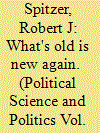|
|
|
Sort Order |
|
|
|
Items / Page
|
|
|
|
|
|
|
| Srl | Item |
| 1 |
ID:
126330


|
|
|
|
|
| Publication |
2013.
|
| Summary/Abstract |
Political science and law intersect not only in the political world, but as disciplines. This is as it should be, and for two important reasons: disciplinary history and content. As Fisher (2009, 798) notes, the first political science graduate program, founded in 1880, studied "history, law, and philosophy." The American Political Science Association, founded in 1903, defined itself in terms of six distinct areas of study, five of which-comparative legislation, international law, constitutional law, administrative law, and jurisprudence-were in some manner about law (798). In addition, law is the expression of authority by the state. Its formation, content, and consequences form the purest expression of governmental power through what we more comprehensively define today as public policy. Early in the history of our discipline, political scientists approached the law in a manner that was "legalistic, formalistic, conceptually barren and largely devoid of what would today be called empirical data" (Somit and Tannenhaus 1967, 69). That is, they approached it as did lawyers of the time. Yet as political science matured, those who studied public law ceased being merely "little lawyers," vesting their work with no less respect for the content of law, but tempered also with the tools and perspectives of what was by now a distinct discipline. No early political scientist better exemplified this maturation than Edward Corwin, especially (although not exclusively) as reflected in his timeless study, The President: Office and Powers (1957).
|
|
|
|
|
|
|
|
|
|
|
|
|
|
|
|
|
|
|
|
|